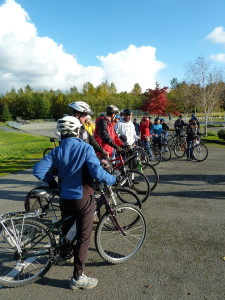 The Bike and Pedestrian Safety Education Program taught by Washington Bikes has been going strong for two years. Parents and teachers have been talking about how they love the program throughout. Now, an evaluation report puts numbers on the impact.
The Bike and Pedestrian Safety Education Program taught by Washington Bikes has been going strong for two years. Parents and teachers have been talking about how they love the program throughout. Now, an evaluation report puts numbers on the impact.
During the two years, the portion of the program funded by a WSDOT grant reached 25 school districts comprising 48 schools, trained 121 teachers, and delivered the curriculum to over 10,000 students between January 2011 and June 2012. Each year, about 10,000 students will continue to be taught the program and approximately 55% of the students who were taught the curriculum live within one mile of school and walked or biked to school.
After teaching the program, a teacher said, “The exposure to a wonderful lifelong activity such as biking is an asset to our community. The feasibility of using a bike as transportation in our community is reinforced with our students when they participate in this program.”
Analyzing before and after surveys about travel behavior and safety skills, the Program Evaluation Report from January 2013 found that students who took part in the program biked and walked more safely.This included an increase in stopping at stop signs, biking on the right side of the road, using hand signals, and wearing a helmet.
Additionally, before and after surveys found that the total percentage of students biking to and from school increased. Before going through the curriculum, 73 surveyed students (2.6%) biked to or from school on an average day. After the curriculum, this rose to 102 students (3.6%).
One district commented that while teaching the class the first year, “some of my kids decided they were going to ride their bikes to school every day! This idea has spread and we now have some unicyclists attempting to ride every day as well.”
To learn more about the Bike and Pedestrian Safety Education Program and to read the full executive summary or full report, go here.



